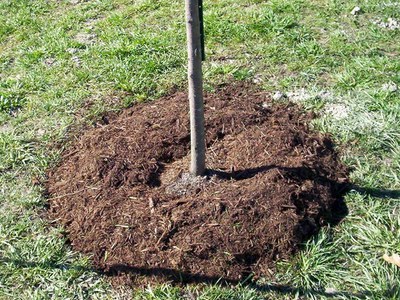Mulch Madness

Do you enjoy torturing plants? If yes, get some rock mulch and place it around your plants.
Rock mulch does nothing for a plant. A rocky bed may look good to us, but the plants are suffering. Use shredded bark instead. It’s better for many reasons:
Shredded bark will moderate soil temperatures. Shredded bark will keep a plant cooler during summer and warmer during winter. Perfect!
Rock mulch is a heat trap. It will scorch plants during the summer and make plants uncomfortable in winter, too. The heat generated from mulch in late winter can lead to buds opening too early and later dying from spring frosts. Rock mulch may lead to premature death of heat-sensitive plant such as birch, mountainash and hosta.
Shredded bark enriches the soil. Shredded bark enhances soil structure, leading to an aerated soil that can hold onto nutrients and moisture. Although there can be a short-term loss of nitrogen, the bark will eventually compensate for this and add more nutrients.
Rock mulch harms the soil. Its weight compacts the ground and destroys air pockets needed for roots to grow. Rocks add no nutrients to the soil.
Shredded bark shields plants from physical damage. Both shredded bark and rock mulches shield plants from lawn mowers, but the jagged edges of rock mulch can harm tender tree and shrub trunks.
Shredded bark reduces drought stress. Both shredded bark and rock mulches conserve moisture, but the heat generated from rock mulch creates greater drought stress on the plants.
Rock mulch is terrible for plants—so why do we use it?
Some gardeners are frustrated that shredded bark can blow away. In windy areas, use a finely shredded bark to minimize the blowing away of mulch.
Some gardeners worry about weeds growing in shredded bark. True, shredded bark will allow more weeds compared to a barrier consisting of rocks and landscape fabric and rocks. But neither mulch will prevent all weeds.
Weeds growing in mulch are generally sparse and pull out easily. Under severe infestations, a spray of However, weeds in shredded bark are generally sparse and pull out easily. A spray of glyphosate once a year may be applied to control tough weeds like quackgrass in beds.
Shredded bark mulch is wonderful for plants. To properly apply it, use the “3-3-3 Rule.” Apply shredded bark in a circle at least 3 feet wide; the wider the better. Take the mulch all the way out to the dripline, if you want.
The mulch should be kept away at least 3 inches away from the trunk and gradually increase in depth to about 3 inches around the edge of the mulch ring.
The next time you plant a tree or shrub, show it some love and surround it with shredded bark. You will be rewarded with a happy, healthy plant.
Written by Tom Kalb, Extension Horticulturist, North Dakota State University.





